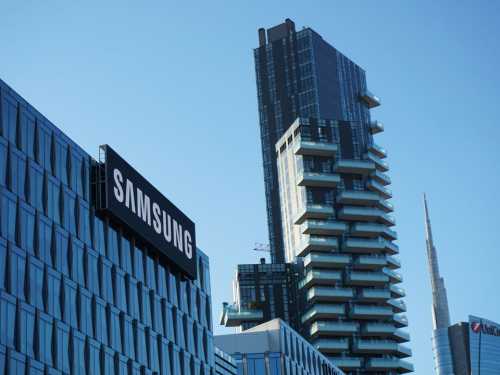
It's hard to believe, but Samsung, whose smartphones and TVs can be found in every home today, started as a small shop selling flour, rice and noodles. But how did a small company manage to become one of the largest electronics manufacturers in the world? What helped it survive wars, political upheavals and economic crises?
Who founded Samsung?
The history of Samsung began in the 1930s in the Korean city of Daegu. Its founder, Lee Byung-cheol, was born in 1910 into a wealthy landowner family in Gyeongsangnam-do Province. He studied at Waseda University in Tokyo, but did not graduate. Thanks to an inheritance from his father, he was able to start his own business at the age of 28.
In 1938, Lee built a rice mill and opened a small shop in Daegu. Times were tough for business—Korea was under Japanese occupation, and private enterprise was severely restricted. But Lee didn’t give up. Month after month, he negotiated with Chinese partners, and by 1938, he had established a channel for exporting products to China and Manchuria.
At that time, the company employed about 40 people. Lee became one of the first Korean entrepreneurs to export not only flour, but also rice, sugar, and dried fish. The success of this venture prompted him to officially register the company under the name Samsung Trading Company.
The name “Samsung” is translated from Korean as “three stars”. The founder himself explained his choice philosophically: the number “three” (Sam) in Korean culture symbolizes something big, strong and numerous, and “stars” (Song) – eternity, brightness and radiance. Thus, the name embodied the founder's desire to create a large, powerful and eternal company. It was these three stars that appeared on the company's first logo.
In 1947, Lee moved the company to Seoul, where the business continued to develop successfully. It is worth noting that the founder of Samsung, Lee Byung-chul, himself, due to his origin from a wealthy family, had connections in influential circles. In his youth, he was acquainted with Lee Syng-man, the future first president of Korea. These connections later played an important role in the development of the company.
During World War II, when many companies suffered losses, Samsung's position only strengthened. After the liberation of South Korea from the Japanese, the company took one of the first steps into production, starting to mass-produce rice vodka and beer – some of the rarest goods of the time, but which, however, sold very well. These products sold so well that within a few years Lee significantly increased his fortune.
Overcoming difficulties
In 1950, the fate of the company was threatened by the outbreak of the Korean War. When American troops were forced to retreat, most of Lee's assets ended up behind the front lines. In Seoul, occupied by North Korean troops, repression began against businessmen accused of collaborating with the Japanese and American regimes. Many businessmen were executed, and only by a miracle did Lee manage to escape. In a matter of days, the entrepreneur lost his many years of business – all warehouses and factories were looted, and his large house was burned down.
In this critical situation, Lee made a bold decision to save some of his assets, including cash, and move to the safer city of Daegu, where he set up new production facilities. This move allowed him to retain key personnel and opened up the possibility of a future revival for the company.
After the war, Samsung was given a new chance to grow. The Lee family's long-standing ties to South Korea's first president, Lee Syng-man, helped the company obtain the necessary licenses for international trade. Realizing that the world was changing rapidly, Lee decided to diversify his business. He opened a sugar refinery, a textile factory, and then expanded the company's influence by acquiring a bank and an insurance company.
However, in 1960, the company faced a new challenge. As a result of the “April Revolution” – mass student protests – President Lee Syng-man was forced to resign. And in 1961, a military coup took place, which brought General Park Chung-hee to power. Samsung's closeness to the previous government caused serious problems for Lee Byung-cheol. Under the threat of imprisonment for tax evasion, he was forced to give the state a controlling stake in the bank.
But even in this situation, Lee's entrepreneurial talent was fully revealed. Instead of accepting the losses, he proposed to the new government a large-scale economic development plan based on close cooperation between the state and big business. This idea became the basis of South Korea's new economic model, which was based on large family conglomerates, known as “chaebols”. As a result, about 30 such flagship businesses were created, which included LG, Hyundai and, of course, Samsung, headed by Lee Byung-cheol. At the same time, each chaebol was assigned a certain role in business and state life. This decision not only helped Lee save the business, but also strengthened his position – he headed the Federation of Korean Industry, becoming one of the key figures in shaping the country's new economic policy.
During this period, Samsung began to look for new directions for development. The company created a successful broadcasting company, but the most important decision was made in 1969, when Lee decided to enter a completely new field for the company – electronics manufacturing.
A new era for Samsung
In 1969, Lee Byung-chul made a strategic decision to enter the electronics market by partnering with the Japanese company Sanyo. This led to the formation of Samsung-Sanyo Electric, the predecessor of today's Samsung Electronics. The company began producing black-and-white televisions, refrigerators, calculators, and air conditioners, primarily for export.
Initially, production was based on Sanyo technology, but Samsung quickly began to develop its own. Two years later, the company began exporting its products to Panama, and in 1974, it mastered the production of the first washing machines and refrigerators, which soon became indispensable appliances in every Korean family.
By the late 1970s, Samsung began producing color televisions. Samsung quickly became the leading manufacturer of appliances in the Korean market. By 1978, two million black-and-white televisions had been produced, and by 1984, color television production had reached 5 million units. Samsung Electronics quickly became a significant player in the market, mastering the production of VCRs.
In parallel with the development of the electronics sector, Lee expanded his business into other areas. In 1973, he agreed with a Japanese corporation to establish a shipbuilding enterprise on the basis of an equal partnership. In April 1977, Samsung acquired the shipyard, and by 1986 the total capacity of the ships built reached 450 thousand tons. The shipbuilding division of Samsung Heavy Industries was among the three largest shipbuilding enterprises in South Korea.
In 1976, the company pioneered a new direction in the entertainment industry by establishing South Korea's first theme park, Samsung Everland, which is now among the top 25 most visited amusement parks in the world.
Technological breakthrough
At 73, when many people are thinking about retirement, Lee Byung-cheol was actively developing new business development strategies. After a year of careful research, on March 15, 1983, he officially announced his investment in the technology of creating super-large integrated circuits. In the same year, Samsung began producing the first personal computers and components for them.
In 1984, the Samsung Semiconductor and Telecommunications Plant was built. In September of that year, the factory began exporting products, laying the foundation for South Korea's future rapid rise in the semiconductor industry.
In 1985, Samsung Data Systems and several research institutes were established to develop its own technologies. The company invested heavily in research and innovation, laying the foundation for its future technological leadership.
Lee Byung-cheol continued to expand the company's sphere of influence. In the same year, Samsung Medical Equipment was founded, specializing in the production of medical equipment.
After Lee Byung-cheol's death in 1987, the company's management passed to his youngest son, Lee Gong-hee, who began a large-scale transformation under the bold slogan “Let's change everything except our wives and children.” The new leader radically changed the company's strategy, abandoning mass production of inexpensive equipment and giving preference to high-quality products that could compete with leading global brands.
Under Lee Gong-hee, the company carried out one of the most successful rebrandings in business history. A new logo was created – a dynamically tilted blue ellipse with the company name inside, which instantly became one of the most recognizable in the world. This case is still studied in leading business schools as a standard of successful rebranding. A deep philosophy was laid in the logo design: the ellipse symbolized the universe and movement in the world space, embodying the idea of constant renewal and improvement of the company.
The early 1990s were marked by the development and production of the first mobile phones. By the end of the decade, the company's successes had gained international recognition – in 1999, Forbes Global magazine awarded Samsung Electronics the Consumer Electronics Award.
Global leader
The 2000s were a time of impressive achievements for Samsung. In 2000, the company set a historic record by selling 100 million color TVs, a feat that no other manufacturer had achieved before.
In 2001, Samsung began producing 512 megabyte flash memory devices. In just two years, the company became the world leader in this field. At the same time, Samsung strengthened its position in the mobile phone market, bypassing such serious competitors as Motorola and Nokia.
By early 2007, Samsung Electronics had taken a leading position in the global market thanks to innovative developments in the field of liquid crystal televisions. The company's product line was constantly expanding – from fitness bracelets to unique washing machines, vacuum cleaners and smartphones.
In 2008, Lee Gong-hee was forced to temporarily step down due to corruption allegations, but returned to leadership in 2010 and continued to develop the company until his death in 2020. During his leadership, Samsung became South Korea's largest conglomerate. In memory of his father, he founded the Hoam Prize, which is awarded annually in seven categories from physics to art.
Around 2015, the company updated its corporate identity, moving to a more minimalist use of a text logo. Samsung is not limited to the production of electronics – the company actively invests in construction, in particular, it participated in the construction of the Burj Khalifa in the UAE, and develops the Shilla Hotels & Resorts hotel chain, which is among the top ten in the world.
In 2022, Samsung marked a significant milestone in its history as Lee Jae-yong, the grandson of the company's founder, officially took over as the CEO of Samsung Electronics. His appointment as executive chairman was approved by the company's board of directors amid growing uncertainty in global markets.
Lee Jae-yong's path to leading the company was not easy. In 2017, he found himself at the center of a major scandal related to the merger of Samsung C&T and Cheil Industries. An investigation revealed irregularities in the merger process, which allowed Lee to gain sole control of the conglomerate. As a result of the legal proceedings, he spent a year in prison, and in 2021 received a new sentence. However, in August 2022, the South Korean president pardoned the businessman, which allowed him to officially lead the company after the death of his father, Lee Gong-hee.
Currently, significant production of Samsung products is concentrated in South Korea, Vietnam, India, Hungary and Malaysia, while the company's products are sold worldwide. By 2024, Samsung Electronics had become one of the most influential and valuable companies in the world, and the entire Samsung conglomerate is one of the largest global conglomerates, worth hundreds of billions of dollars, and it is consistently ranked among the world's leading companies. The company employs 270,000 employees in 74 countries.
However, not all areas of Samsung's business are developing equally successfully. While the company is holding its own in the smartphone sector, the television sector has faced serious challenges in recent years. Increased competition from Chinese manufacturers is forcing Samsung to look for new ways to develop in this traditionally strong segment for the company.






